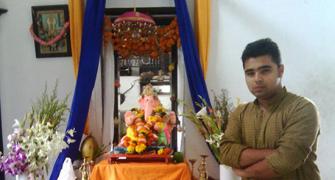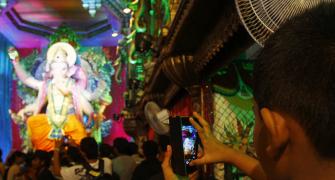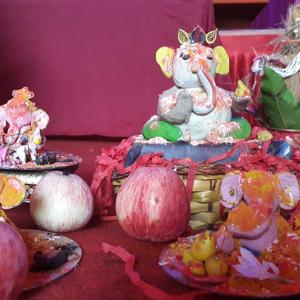In a tiny lane that leads away from Worli Naka, central Mumbai, on a rainy Thursday evening, members of Patil family are busy making last minute preparations for the visarjan (immersion) of Gauri and Ganapati.
Nandu Patil, who is the eldest in the family, is hosting the celebrations with his wife Sulochana.
"The visarjan is a very emotional moment for us," says Sulochana solemnly, as she explains the significance of the Goddess.
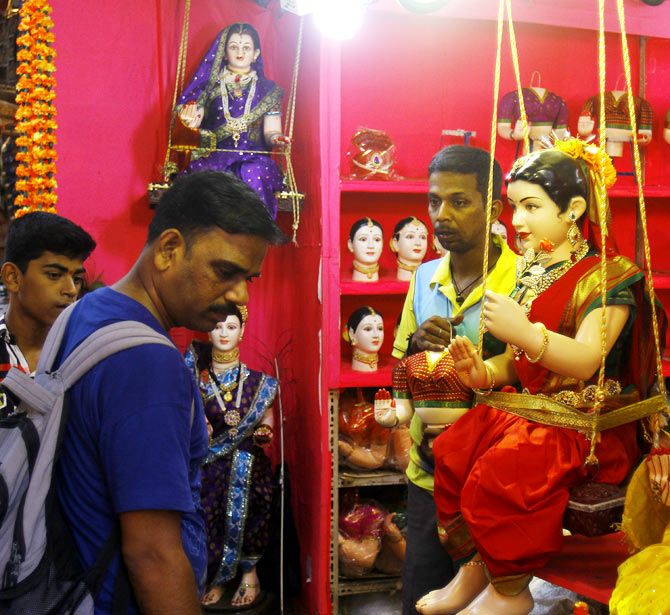
Goddess Gauri is invited home and worshipped for three days.
Married women pray to her for marital bliss and the long life of their husbands. Unmarried girls worship her in order to get virtuous husbands.
The Gauri puja begins on the third day after Ganesh Chaturthi.
This day is known as the avahana (arrival) as it is on this day that the Goddess is brought into the home.
Following our tradition, the married women in the house draw small footsteps of the Goddess using rangoli (coloured) powder, following which Gauri's murti (idol) is brought home.
Some families don't bring a murti; instead, they bring a picture of Gauri.
In our family, the Goddess arrives as a pair -- one is Jyeshta (the elder one) and another is Kanishta (the younger one).
The vessels that hold the grain form the base and act as the Goddess's body; Gauri's head is placed on top.
This is followed by a small puja.
In the evening, married women come home and dress Goddess Gauri in a new sari.
Normally, the colour of the sari is green. This is because Ganesh Chaturthi falls during the monsoon season, when everything is green.
They also decorate the idol with ornaments like a nose ring, toe rings, bangles, a mangalsutra and earrings. All these are worn by married women to indicate their marital status.
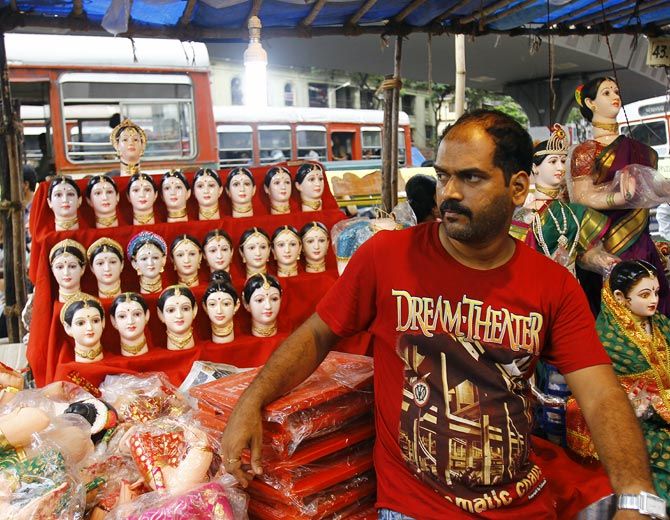
On the second day, we organise a Gauri puja. We do this to offer our gratitude to Lord Ganpati and Goddess Gauri for the well-being and prosperity of the family.
After the puja, we offer the 'Naivedya' (special food) to Goddess Gauri. Various delicacies -- sweet and savoury -- are prepared as part of these offerings. Some families also offer meat and fish dishes.
The family then eat the same dishes which are prepared for the Naivedya.
Later on, we sing bhajans (hymns) and pray to Gauri for health, wealth, success and prosperity.
The women in our family stay awake through the night and sing Mangala Gauri songs. These songs reflect the lifestyle of married women.
Earlier, we would also dance traditional dances and play traditional games like phugadi and zhimma, but we don't do that any more.
Participating in this gathering is considered very auspicious, particularly or a newly married woman who is celebrating her first Mangala Gauri.
The male members of the family cannot participate in this gathering.
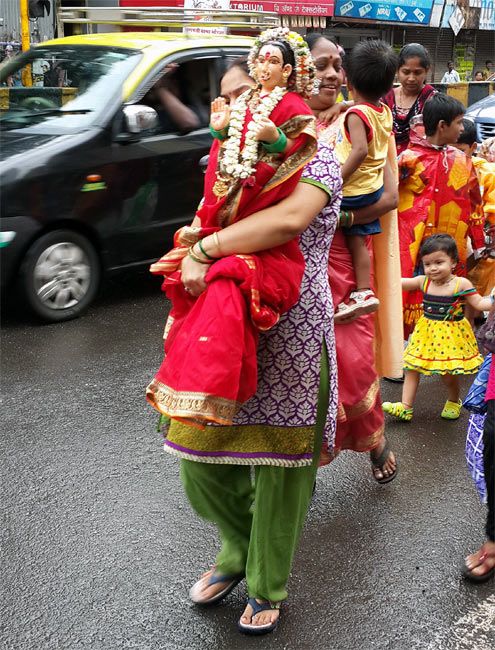
Day 3
The Gauri visarjan takes place on the sixth or seventh day of Ganesh Chaturthi (depending on the mahurat), along with the Ganpati visarjan. This year, the mahurat (auspicious time) fell on the seventh day.
Before the visarjan, our family hosts a haldi-kumkum ceremony.
In this ceremony, the married women exchange haldi (turmeric powder) and kumkum (vermillion powder), which symbolises their marital status. They pray to Gauri, asking her to grant their husbands good health and a long, prosperous life.
We also use five pebbles (paan khade) during the rituals. These are placed alongside the Gauri idol during the prayers. The pebbles are later immersed in the water.
In the evening, the visarjan aarti is performed. Our family prepares a special prasad of cooked rice mixed with sugar. This prasad is offered to God and later is distributed among the devotees.
The murtis are finally taken to Shivaji Park beach in Dadar (central Mumbai) where we perform the final aarti before we immerse them in the water.
Sulochana Patil spoke to Sonil Dedhia/Rediff.com.
DON'T MISS!
Day 1: Ganpati Bappa Morya! Bringing the Lord home
Day 2: Mumbaicha Raja and a sea of devotees
Day 3: Goodbye Ganesha… it's not easy to let You go
Day 4: The Ganeshotsav festival's biggest tragedy!
Day 5: 'It was pure love for the Lord'
Day 6: Why Mumbai visarjans are so orderly
Day 7: This Ganpati is edible, so nothing goes waste
Day 9: Band, Baaja, Bappa: It's a grand farewell party
Day 10:'We can go hungry, but bringing home Ganesha is mandatory'

